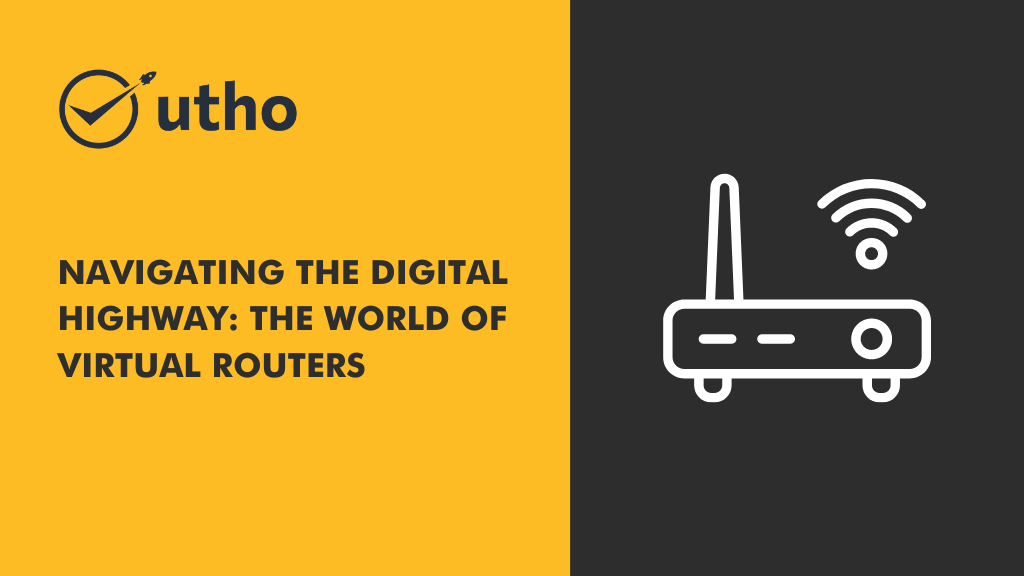In today's world where everything is connected through digital technology, the need for strong and adaptable networking solutions is greater than ever. Businesses of all sizes are always looking for ways to make their networks work better, so they stay connected without any interruptions. Virtual routers have become a big deal in this effort. This article dives into the world of virtual routers, looking at how they've grown, what they offer now, why they're useful, and what might be ahead for them.
What do we mean by Virtual Routers?
Virtual routers are software-based entities designed to replicate the functionalities of physical routers within a network. They operate on virtualized hardware and are managed through software interfaces. In simple terms, virtual routers are like digital versions of physical routers, serving as the backbone for routing network traffic without the need for dedicated hardware devices. They are commonly used in cloud computing environments, virtual private networks (VPNs), and software-defined networking (SDN) architectures.
What are the benefits of using virtual routers?
Using virtual routers offers several benefits:
Cost Savings: Virtual routers eliminate the need for purchasing dedicated physical hardware, reducing upfront costs. Organizations can leverage existing server infrastructure or cloud resources, leading to significant cost savings.
Scalability: Virtual routers can easily scale up or down based on network demands by allocating or deallocating virtual resources. This scalability allows organizations to adapt to changing requirements without investing in new hardware.
Flexibility: Virtual routers offer flexibility in configuration and deployment options. They can be quickly provisioned, modified, or decommissioned to meet specific network needs, providing agility in network management.
Resource Utilization: By running on virtualized hardware, virtual routers can share resources such as CPU, memory, and storage with other virtual machines. This maximizes resource utilization and minimizes wasted capacity.
Ease of Management: Virtual routers are typically managed through software interfaces, offering centralized control and streamlined configuration. This simplifies network management tasks, reduces the need for manual intervention, and minimizes the risk of errors.
High Availability: Virtualization technologies enable features such as failover clustering and live migration, enhancing the availability of virtual routers. This reduces downtime and associated costs related to network disruptions or hardware failures.
Testing and Development: Virtual routers provide a cost-effective solution for creating test environments and conducting network experiments without disrupting production systems. They enable developers and network engineers to simulate various scenarios and validate configurations before deployment.
Security: Virtual routers can be configured with security features such as access control lists (ACLs), firewall rules, and VPN encryption to protect network traffic. This enhances network security and compliance with regulatory requirements.
Overall, using virtual routers brings cost savings, scalability, flexibility, and enhanced management capabilities to network environments, making them a preferred choice for modern enterprises.
How does a virtual router operate?
The functioning mechanism of a virtual router involves several key components and processes:
Virtualization Layer: Virtual routers operate within a virtualization layer, which abstracts hardware resources and provides a platform for running multiple virtual machines (VMs) on a single physical server.
Virtual Machine Creation: A virtual router is created as a virtual machine instance within the virtualization environment. This involves allocating virtual CPU, memory, storage, and network resources to the virtual router VM.
Operating System Installation: An operating system compatible with router software is installed on the virtual machine. Common choices include Linux-based distributions or specialized router operating systems like VyOS or pfSense.
Router Software Installation: Router software is installed on the virtual machine to provide routing functionality. This software could be open-source solutions like Quagga, proprietary router software, or purpose-built virtual router appliances provided by vendors.
Network Configuration: The virtual router is configured with network interfaces, IP addresses, routing tables, and other parameters necessary for routing traffic within the network environment. This configuration is typically done through a command-line interface (CLI) or a web-based management interface.
Routing Protocols: Virtual routers use routing protocols such as OSPF (Open Shortest Path First), BGP (Border Gateway Protocol), or RIP (Routing Information Protocol) to exchange routing information with neighboring routers and make forwarding decisions.
Packet Forwarding: When a packet arrives at the virtual router, it examines the packet's destination IP address and consults its routing table to determine the next hop for the packet. The virtual router then forwards the packet to the appropriate network interface or forwards it to another router based on routing protocol information.
Security and Access Control: Virtual routers implement security features such as access control lists (ACLs), firewall rules, VPN encryption, and authentication mechanisms to protect network traffic and enforce security policies.
Monitoring and Management: Virtual routers support monitoring and management functionalities for network administrators to monitor traffic, troubleshoot issues, and perform configuration changes. This includes features like SNMP (Simple Network Management Protocol), logging, and remote access interfaces.
High Availability and Redundancy: Virtual routers can be configured for high availability and redundancy using techniques such as virtual machine clustering, load balancing, and failover mechanisms to ensure continuous operation and minimize downtime.
By orchestrating these components and processes, virtual routers emulate the functionality of physical routers within a virtualized environment, enabling efficient routing of network traffic in enterprise environments.
How do virtual routers contribute to cost savings and efficiency in network management?
Virtual routers contribute to cost savings and efficiency in network management through several key factors:
Reduced Hardware Costs: Virtual routers eliminate the need for purchasing dedicated physical router hardware, which can be expensive. Instead, they utilize existing server infrastructure or cloud resources, reducing upfront hardware costs.
Resource Sharing: By running on virtualized hardware, virtual routers can share resources such as CPU, memory, and storage with other virtual machines. This maximizes resource utilization and minimizes wasted capacity, leading to cost savings.
Scalability: Virtual routers can easily scale up or down based on network demands by allocating or deallocating virtual resources. This scalability allows organizations to adapt to changing requirements without investing in new hardware, thereby saving costs.
Consolidation: Multiple virtual routers can run on the same physical server or within the same virtual environment. This consolidation reduces the number of physical devices needed, simplifying network management and lowering operational costs.
Ease of Management: Virtual routers are typically managed through software interfaces, which offer centralized control and streamlined configuration. This simplifies network management tasks, reduces the need for manual intervention, and minimizes the risk of errors, leading to operational efficiency and cost savings.
High Availability: Virtualization technologies enable features such as failover clustering and live migration, which enhance the availability of virtual routers. This reduces downtime and associated costs related to network disruptions or hardware failures.
Testing and Development: Virtual routers facilitate easy creation of test environments and sandbox networks without the need for additional physical hardware. This accelerates testing and development cycles, leading to faster deployment of network changes and cost savings through improved efficiency.
Overall, virtual routers offer cost savings and efficiency benefits by leveraging virtualization technologies to optimize resource utilization, streamline management, and enhance scalability and availability in network environments.
What are some common use cases for virtual routers in enterprise environments?
Virtual routers find numerous applications in enterprise environments due to their flexibility, scalability, and cost-effectiveness. Here are some common use cases.
Virtual Private Networks (VPNs): Virtual routers are often deployed to provide secure remote access to corporate networks for remote employees or branch offices. They facilitate the establishment of encrypted tunnels, enabling secure communication over public networks.
Software-Defined Networking (SDN): In SDN architectures, virtual routers play a crucial role in network abstraction and programmability. They help centralize network control and enable dynamic configuration changes based on application requirements.
Network Segmentation: Enterprises use virtual routers to partition their networks into separate segments for security or performance reasons. This allows for the isolation of sensitive data, compliance with regulatory requirements, and efficient traffic management.
Load Balancing: Virtual routers can be employed to distribute network traffic across multiple servers or data centers to optimize resource utilization and improve application performance. They help ensure high availability and scalability for critical services.
Disaster Recovery: Virtual routers are utilized in disaster recovery setups to replicate network infrastructure and ensure business continuity in case of outages or failures. They enable failover mechanisms and seamless redirection of traffic to backup sites.
Cloud Connectivity: Enterprises leverage virtual routers to establish connections between on-premises networks and cloud platforms, such as AWS, Azure, or Google Cloud. This enables hybrid cloud deployments and facilitates seamless data transfer between environments.
Network Testing and Development: Virtual routers provide a cost-effective solution for creating test environments and conducting network experiments without disrupting production systems. They enable developers and network engineers to simulate various scenarios and validate configurations before deployment.
Traffic Monitoring and Analysis: Virtual routers support the implementation of traffic monitoring and analysis tools, such as packet sniffers or intrusion detection systems (IDS). They enable real-time traffic inspection, logging, and reporting for network troubleshooting and security purposes.
Service Chaining: Enterprises deploy virtual routers in service chaining architectures to route network traffic through a sequence of virtualized network functions (VNFs), such as firewalls, load balancers, and WAN accelerators. This enhances network security and performance.
Edge Computing: In edge computing environments, virtual routers are used to extend network connectivity to edge devices, such as IoT sensors or edge servers. They enable local processing of data and reduce latency for time-sensitive applications.
By addressing these use cases, virtual routers empower enterprises to build flexible, resilient, and efficient network infrastructures that meet their evolving business needs.
How does Utho Cloud ensure the security and reliability of its Virtual Router offering?
Utho Cloud ensures the security and reliability of its Virtual Router offering through several measures:
Robust Security Features: Utho Cloud incorporates robust security features into its Virtual Router offering, including encryption, authentication, and access controls. These features help safeguard data and prevent unauthorized access to network resources.
Compliance Certifications: Utho Cloud adheres to industry standards and compliance certifications, such as ISO 27001 and SOC 2, to ensure the security and privacy of customer data. These certifications demonstrate Utho's commitment to maintaining the highest standards of security and reliability.
Redundant Infrastructure: Utho Cloud's Virtual Router offering is built on redundant infrastructure to ensure high availability and reliability. This includes multiple data centers and network paths to mitigate the risk of downtime and ensure uninterrupted service.
Monitoring and Management Tools: Utho Cloud provides comprehensive monitoring and management tools for its Virtual Router offering, allowing users to monitor network performance, detect potential security threats, and manage network configurations effectively.
Continuous Updates and Patching: Utho Cloud regularly updates and patches its Virtual Router software to address security vulnerabilities and ensure optimal performance. These updates are applied automatically to minimize downtime and reduce the risk of security breaches.
Overall, Utho Cloud prioritizes security and reliability in its Virtual Router offering by implementing robust security features, maintaining compliance certifications, leveraging redundant infrastructure, providing monitoring and management tools, and ensuring continuous updates and patching.
As organizations continue to navigate the digital highway, embracing the innovation of virtual routers opens up a world of possibilities for optimizing performance and staying ahead in the ever-evolving digital era. With the reliability and security measures in place, virtual routers pave the way for a smoother journey towards a connected future.




